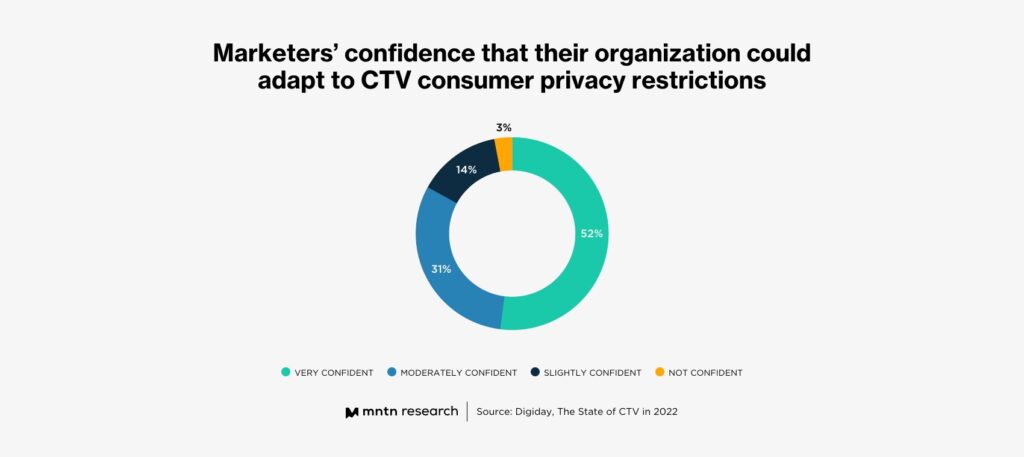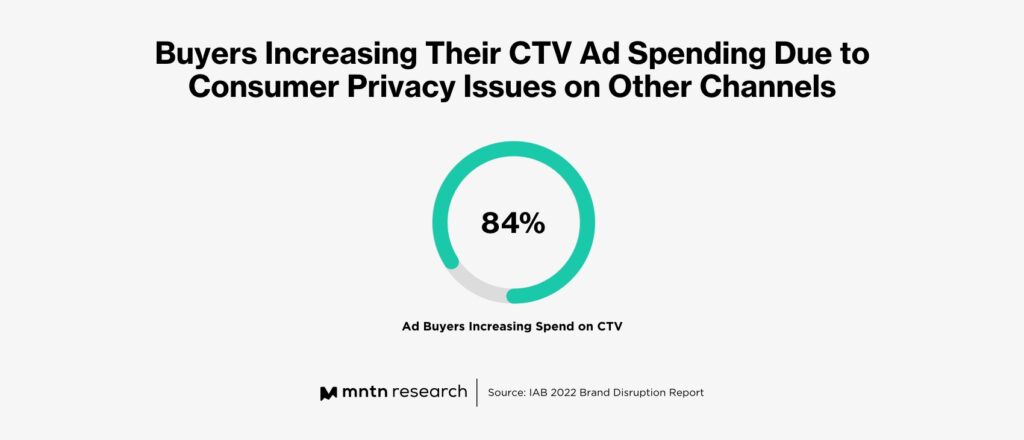What Advertisers Need to Know About CTV and the Future of Consumer Privacy Restrictions
by Stephen Graveman4 min read
Abstract
- Viewership and ad spend are increasing on CTV – renewing interest in how consumer privacy laws impact the channel
- CTV has mostly been unaffected by privacy changes thanks to its pro-privacy mindset
- 84% of advertisers are increasing CTV ad spend due to consumer privacy issues on other ad channels
- 83% of advertisers are confident in their ability to easily adapt to consumer privacy restrictions on CTV

Connected TV advertising continues to grow at an accelerated rate, with projected ad spend to reach $19.1 billion by the end of 2022 and more than 55% of advertisers shifting marketing budgets away from other channels and towards CTV. As both spending and viewership increase, more data is collected, and targeted ads are delivered, there has been an increased focus on how CTV both follows consumer privacy laws and protects the PII (personally identifiable information) of viewers.
Thankfully for advertisers and consumers, CTV is ahead of other advertising avenues with regard to data privacy compliance. Regardless, there are still improvements that can be made in the space and steps that advertisers can take to better prepare for the future of data compliance and CTV.
CTV and Privacy Changes
While sweeping privacy changes are frequently impacting the advertising world, Connected TV has been mostly spared from any legislative fallout. As the industry continues to depreciate the third-party cookie and major hardware and software providers revisit their privacy consent agreements, there has been a renewed interest in how Connected TV might be impacted by any future privacy regulations and changes.

The arrival of the GDPR, CCPA, CPRA, and even initiatives from private organizations like Apple’s IDFA have put an even brighter spotlight on consumer privacy rights – and provide very steep punishments for advertisers who run afoul of them. As a result, advertisers are becoming increasingly aware of consumer privacy changes and it’s fueling further CTV adoption rates as the death of the third-party cookie has them reallocating media budgets away from other channels. According to the IAB 2022 Brand Disruption Report, 84% of buyers increasing their CTV spending did so because of consumer privacy concerns on other ad channels. Further, in the years since privacy regulations like GDPR and CCPA appeared, advertisers have become very familiar with the impact they have on brands and how to navigate a post-compliance world.
Thankfully, CTV has avoided scrutiny and has been mostly unaffected by privacy changes thanks to its future-proofed design and consumer privacy mindset. Any data that is collected to target and serve ads is anonymized and is used without any problematic technology solutions like third-party cookies. As Chris Innes, Chief Operating Officer at MNTN, recently elaborated to Digiday, “CTV is already ahead of digital and social when it comes to privacy. The channel doesn’t support cookies and is a tool for communicating ad messages to a mass audience.”
“CTV is already ahead of digital and social when it comes to privacy. The channel doesn’t support cookies and is a tool for communicating ad messages to a mass audience.”
– Chris Innes, Chief Operating Officer, MNTN
How Advertisers Can Prepare for a Privacy Future
Having a privacy mindset baked into the platform has had an impact on how advertisers view CTV and consumer privacy changes. When Digiday asked marketers their level of confidence in easily adapting to consumer privacy restrictions in the CTV space, a total of 83% were either very or moderately confident.
One way advertisers can build a privacy-forward strategy is by purchasing premium inventory on a private marketplace (PMP). With a PMP, select buyers can access a curated ad inventory offered by trusted publishers. Inventory is purchased on this marketplace, which is built through direct deals with the publishers, ensuring that advertisers know they’re getting access to valid audiences on premium inventory, sourced from legitimate data collection.
This provides more control for both ad buyer and publisher, lowering fees and granting better inventory access by connecting both parties directly.
Future Opportunities for Privacy and CTV
While advertiser consumer confidence remains high, there are still opportunities for CTV to continue innovating. While desktop and mobile users have a high level of control over what amount of their data is shared and monetized with advertisers and platforms, CTV doesn’t have the same level of control or opt-outs.
One potential solution lies in a familiar technology, the QR code. “On every TV commercial, there should be a small QR code in the top right corner that allows people to see who is serving the ad, what campaign it’s part of, what brand purchased it, and where the targeting data is coming from,” noted Innes.
To prepare for any future changes, advertisers have begun educating themselves on the intricacies of CTV and privacy regulations by studying topics including IP addresses and data targeting. By building a knowledge base
Conclusion
Thanks to its pro-privacy mindset, advertiser confidence in CTV’s ability to navigate privacy laws and restrictions remains high. As the scope of a customer experience on CTV continues to expand—74% of CTV viewers use multiple channels to begin, continue, and convert—CTV’s ability to stay are the forefront of advertising channels protecting PII and staying compliant will continue to drive further growth potential.
Subscribe to the MNTN Research Weekly
Sign up to receive a weekly feed of curated research, sent straight to your inbox.
Resources